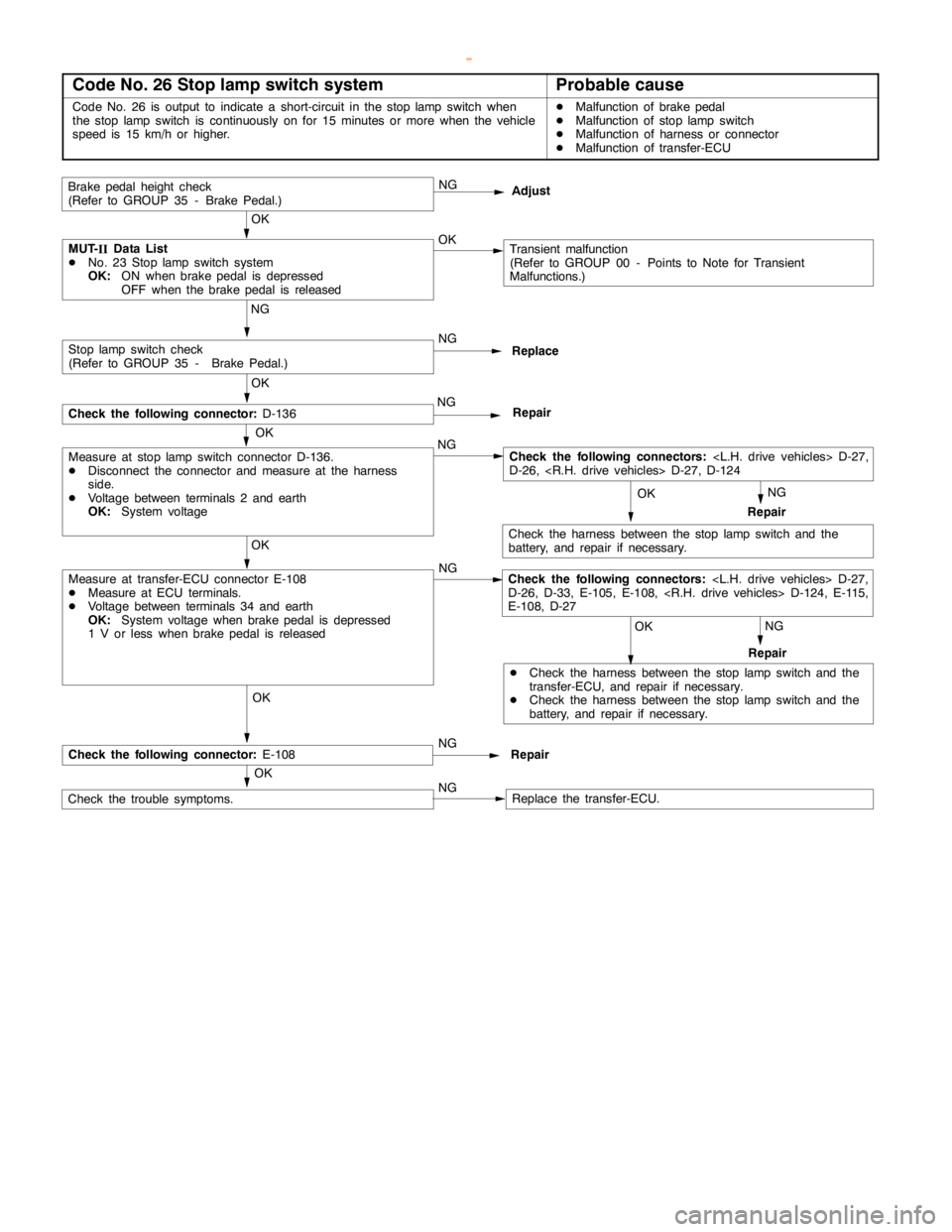2000 MITSUBISHI MONTERO brake
[x] Cancel search: brakePage 980 of 1839

AUTOMATIC TRANSMISSION -Troublehshooting
Code No. 26 Stop lamp switch systemProbable cause
Code No. 26 is output to indicate a short-circuit in the stoplampswitch when
the stoplampswitch is continuously on for 15 minutes or more when the vehicle
speed is 15 km/h or higher.DMalfunction of brakepedal
DMalfunction of stoplampswitch
DMalfunction of harness or connector
DMalfunction of transfer-ECU
NG
NG
NG
MUT-
IIData List
DNo. 23 Stoplampswitch system
OK:ON when brakepedal is depressed
OFF when the brakepedal is releasedTransient malfunction
(Refer to GROUP 00 - Points to Note for Transient
Malfunctions.) OK
OK OK OK NG
DCheck the harness between the stoplampswitch and the
transfer-ECU, and repair if necessary.
DCheck the harness between the stoplampswitch and the
battery, and repair if necessary.Repair
Check the harness between the stoplampswitch and the
battery, and repair if necessary.
OK OK
Brakepedal heightcheck
(Refer to GROUP 35 - Brake Pedal.)
OKNG
Adjust
OK
OK
NG
NG
Check the trouble symptoms.Replace the transfer-ECU.
Measure at transfer-ECU connector E-108
DMeasure at ECU terminals.
DVoltage between terminals 34 and earth
OK:System voltage when brakepedal is depressed
1 V or less when brakepedal is released
Measure at stoplampswitch connector D-136.
DDisconnect the connector and measure at the harness
side.
DVoltage between terminals 2 and earth
OK:System voltageNG
Replace
NG
Repair
Stoplampswitch check
(Refer to GROUP 35 - Brake Pedal.)
Check the following connector:D-136
Repair NG
Check the following connector:E-108Repair
Check the following connectors:
D-26, D-33, E-105, E-108,
E-108, D-27
Check the following connectors:
D-26,
www.WorkshopManuals.co.uk
Purchased from www.WorkshopManuals.co.uk
Page 989 of 1839

AUTOMATIC TRANSMISSION -Troubleshooting
Item
No.Normal condition Inspection conditions Check item
21Ignition switchIgnition switch: ONON
Ignition switch: OFFOFF
22Transmission identi-
ficationVehicles with A/TA/T
23Stop lamp switchIgnition switch: ONBrake pedal: DepressedON
Engine: StoppedBrake pedal: ReleasedOFF
24Transfer leverTransfer shift lever position: 2HON
switch 2HTransfer shift lever position: Other than the aboveOFF
25Transfer leverTransfer shift lever position: 4HON
switch 4HTransfer shift lever position: Other than the aboveOFF
26Transfer leverTransfer shift lever position: 4HLcON
switch 4HLcTransfer shift lever position: Other than the aboveOFF
27Transfer leverTransfer shift lever position: 4LLcON
switch 4LLcTransfer shift lever position: Other than the aboveOFF
28Engine identificationPetrol vehiclesPETROL
Diesel vehiclesDIESEL
30Freewheel engageDuring 2WDON
solenoid valveDuring 4WDOFF
31Inhibitor switch NSelector lever position: NON
Selector lever position: Other than the aboveOFF
32Inhibitor switch PSelector lever position: PON
Selector lever position: Other than the aboveOFF
332WD switchDriving conditions: 2WD (2H)ON
Driving conditions: Other than the aboveOFF
342WD/4WD switchDriving conditions: 2WD (2H), 4WD (4H)ON
Driving conditions: Other than the aboveOFF
354H switchDriving conditions: 4WD (4H), 4WD (4HLc)ON
Driving conditions: Other than the aboveOFF
36Center differentialDriving conditions: 4WD (4HLc), 4WD (4LLc)ON
lock switchDriving conditions: Other than the aboveOFF
374LLc switchDriving conditions: 4WD (4LLc)ON
Driving conditions: Other than the aboveOFF
38Freewheel engageDuring 2WDOFF
switchDuring 4WDON
www.WorkshopManuals.co.uk
Purchased from www.WorkshopManuals.co.uk
Page 991 of 1839

AUTOMATIC TRANSMISSION -Troubleshooting
Ter-
minal
No.Check itemInspection conditionsStandard value
1Shift actuatorTransfer shift lever position: 2H®4H5.6 V®11.0 V®
5.6 V
3Shift actuatorTransfer shift lever position: 4H®2H5.6 V®11.0 V®
5.6 V
5Accelerator pedal positionAccelerator pedal: Fully closed (engine stopped)0.985 - 1.085 V
sensor (APS)Accelerator pedal: Fully open (engine stopped)4.0 V or higher
7Front propeller shaft speed
sensorMeasure the voltage between terminals 7 and 18 using
an oscilloscope.
Engine: 2 000 r/min
Shift range: 4thOscilloscope check
procedure (Refer to
P. 23-69
9Rear propeller shaft speed
sensorMeasure the voltage between terminals 9 and 18 using
an oscilloscope.
Engine: 2 000 r/min
Shift range: 4thOscilloscope check
procedure (Refer to
P. 23-69
11Diagnosis outputWhen normal (no diagnosis codes are output)0 V and 5 V alterna-
tes
13Power supplyIgnition switch: OFF0V
Ignition switch: ONSystem voltage
18Sensor earthAt all times0.5 V or less
20Transfer lever switch 2HTransfer shift lever position: 2HSystem voltage
Transfer shift lever position: Other than the above0V
21Transfer lever switch 4HTransfer shift lever position: 4HSystem voltage
Transfer shift lever position: Other than the above0V
22Transfer lever switch 4HLcTransfer shift lever position: 4HLcSystem voltage
Transfer shift lever position: Other than the above0V
23Transfer lever switch 4LLcTransfer shift lever position: 4LLcSystem voltage
Transfer shift lever position: Other than the above0V
24Diagnosis control––
25EarthAt all times0V
26EarthAt all times0V
31Backup power supplyAt all timesSystem voltage
32Inhibitor switch NSelector lever position: NSystem voltage
Selector lever position: Other than the above0V
33Inhibitor switch PSelector lever position: PSystem voltage
Selector lever position: Other than the above0V
34Stop lamp switchBrake pedal: DepressedSystem voltage
Brake pedal: Released0V
35EarthAt all times0V
37Rear wheel indicator lampOther than during transfer selectionSystem voltage
38Front wheel indicator lampDuring 4WDSystem voltage
39Earth <6G7>At all times0V
www.WorkshopManuals.co.uk
Purchased from www.WorkshopManuals.co.uk
Page 993 of 1839

AUTOMATIC TRANSMISSION -
Troubleshooting
TROUBLESHOOTING
DIAGNOSIS FUNCTION
Input signal check procedure
Connect the MUT-II
or a voltage meter to the diagnosis connector, and check the inhibitor switch (reverse)
input signal.
(Refer to GROUP 00 - Guide to Troubleshooting and Inspection Procedures.)
INSPECTION CHART CLASSIFIED BY TROUBLE SYMPTOMS
Trouble SymptomInspection
procedure
No.Reference
page
When the ignition switch is at a position other than the LOCK position, the selector lever
can be moved from the P to the R position even though the brake pedal is not depressed.123-92
When the ignition switch is at a position other than the LOCK position, the selector lever
cannot be moved from the P to the R position even though the brake pedal is being
depressed.223-92
The ignition switch is at the LOCK position, but the selector lever can be moved from the
P to the R position when the brake pedal is depressed.323-93
The selector lever cannot be easily moved from the P to the R position.423-93
The selector lever cannot be moved from the R to the P position.523-93
The ignition key cannot be turned to the LOCK position when the selector lever is at the P
position.623-93
The ignition key can be turned to the LOCK position even when the selector lever is at a
position other than the P position.723-93
INSPECTION PROCEDURES FOR TROUBLE SYMPTOM
Inspection procedure 1
When the ignition switch is at a position other than the
LOCK position, the selector lever can be moved from the
P to the R position even though the brake pedal is not
depressed.
Probable cause
The cause is probably a malfunction of the selector lever assembly lock cam or
of the shift lock cable unit.DMalfunction of lock cam
DMalfunction of shift lock cable unit
Check by referring to the probable causes.
Inspection procedure 2
When the ignition switch is at a position other than the
LOCK position, the selector lever cannot be moved from
the P to the R position even though the brake pedal is
being depressed.
Probable cause
The cause is probably a malfunction of the selector lever assembly, transmission
control cable, shift lock cable unit or the ignition key cylinder lock bar.DMalfunction of selector lever assembly
DMalfunction of transmission control cable
DMalfunction of shift lock cable unit
DMalfunction of lock bar
Check by referring to the probable causes.
www.WorkshopManuals.co.uk
Purchased from www.WorkshopManuals.co.uk
Page 994 of 1839

AUTOMATIC TRANSMISSION -Troubleshooting
Inspection procedure 3
The ignition switch is at the LOCK position, but the
selector lever can be moved from the P to the R position
when the brake pedal is depressed.
Probable cause
The cause is probably a malfunction of the shift lock cable unit or of the ignition
key cylinder lock bar.DMalfunction of shift lock cable unit
DMalfunction of lock bar
Check by referring to the probable causes.
Inspection procedure 4
The selector lever cannot be easily moved from the P to
the R position.
Probable cause
The cause is probably a malfunction of the selector lever assembly, transmission
control cable, shift lock cable unit or the ignition key cylinder lock bar.DMalfunction of selector lever assembly
DMalfunction of transmission control cable
DMalfunction of shift lock cable unit
DMalfunction of lock bar
Check by referring to the probable causes.
Inspection procedure 5
The selector lever cannot be moved from the R to the P
position.
Probable cause
The cause is probably a malfunction of the selector lever assembly or of the
transmission control cable.DMalfunction of selector lever assembly
DMalfunction of transmission control cable
Check by referring to the probable causes.
Inspection procedure 6
The ignition key cannot be turned to the LOCK position
when the selector lever is at the P position.
Probable cause
The cause is probably a malfunction of the selector lever assembly, shift lock
cable unit or the ignition key cylinder lock bar.DMalfunction of selector lever assembly
DMalfunction of shift lock cable unit
DMalfunction of lock bar
Check by referring to the probable causes.
Inspection procedure 7
The ignition key can be turned to the LOCK position even
when the selector lever is at a position other than the P
position.
Probable cause
The cause is probably a malfunction of the shift lock cable unit or of the ignition
key cylinder lock bar.DMalfunction of shift lock cable unit
DMalfunction of lock bar
Check by referring to the probable causes.
www.WorkshopManuals.co.uk
Purchased from www.WorkshopManuals.co.uk
Page 1209 of 1839

BASIC BRAKE SYSTEM
Click on the applicable bookmark to selected the required model year.
www.WorkshopManuals.co.uk
Purchased from www.WorkshopManuals.co.uk
Page 1210 of 1839

35A-2
BASIC BRAKE
SYSTEM
CONTENTS
GENERAL INFORMATION 3..................
SERVICE SPECIFICATIONS 5.................
LUBRICANTS 6..............................
SPECIAL TOOLS 6..........................
TROUBLESHOOTING
ON-VEHICLE SERVICE 19...................
Brake Pedal Check and Adjustment 19..........
Hydraulic Brake Booster (HBB) Operation Check
HBB Check
HBB Motor Relay Continuity Check
Brake Booster Operating Test
Check Valve Operation Check
Load Sensing Spring Length Check and
Adjustment
Load Sensing Proportioning Valve Function
Test
Bleeding
Brake Fluid Level Sensor Check 30.............
Brake Booster Vacuum Switch Check
Disc Brake Pad Check and Replacement 31.....
Disc Brake Rotor Check 32.....................
Brake Disc Thickness Check 32.................
Brake Disc Run-out Check and Correction 33....
BRAKE PEDAL 34..........................
HYDRAULIC BRAKE BOOSTER (HBB)
HBB BUZZER
MASTER CYLINDER AND BRAKE
BOOSTER
Master Cylinder 43.............................
FRONT DISC BRAKE 44....................
REAR DISC BRAKE 49......................
LOAD SENSING PROPORTIONING
VALVE
www.WorkshopManuals.co.uk
Purchased from www.WorkshopManuals.co.uk
Page 1211 of 1839

BASIC BRAKE SYSTEM -General Information35A-3
GENERAL INFORMATION
The brake system offers high dependability and durability along with improved braking performance and
brake sensitivity.
ItemsSpecifications
Hydraulic brake boosterMaster cylinder typeSingle type (with center valve)
(HBB)
Boosting ratio5.4
Master cylinderTypeTandem type
Brake boosterTypeVacuum type, tandem
Boosting ratio6.5
Rear wheel hydraulic pressure control type
Load sensing proportioning
valve
Front brakesTypeFloating caliper, 2 piston, ventilated disc
Disc effective dia.¢
thickness mm241¢
26
Wheel cylinder I.D. mm45.4
Pad thickness mm10.0
Clearance adjustmentAutomatic
Rear brakesTypeFloating caliper, 1 piston, ventilated disc
Disc effective dia.¢
thickness mm256¢
22
Wheel cylinder I.D. mm44.5
Pad thickness mm10.0
Clearance adjustmentAutomatic
Brake fluidDOT3 or DOT4
www.WorkshopManuals.co.uk
Purchased from www.WorkshopManuals.co.uk